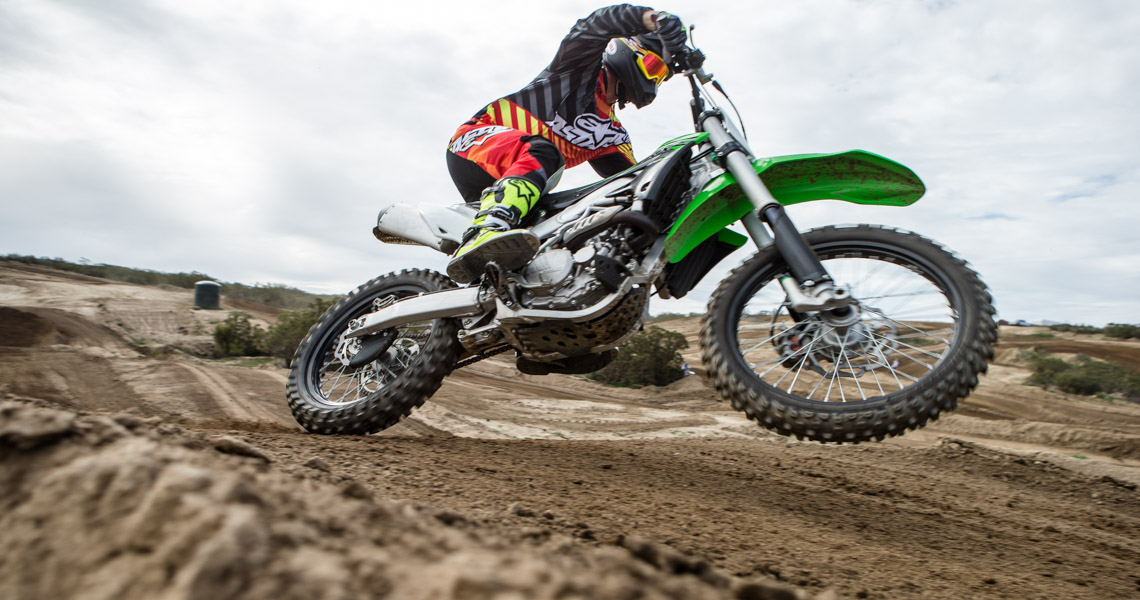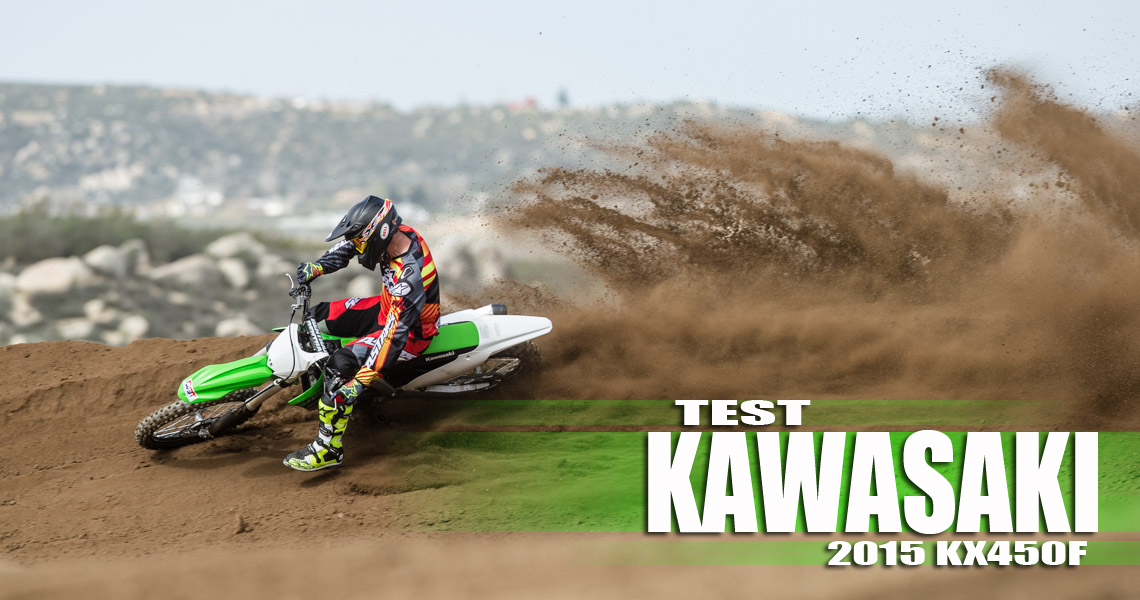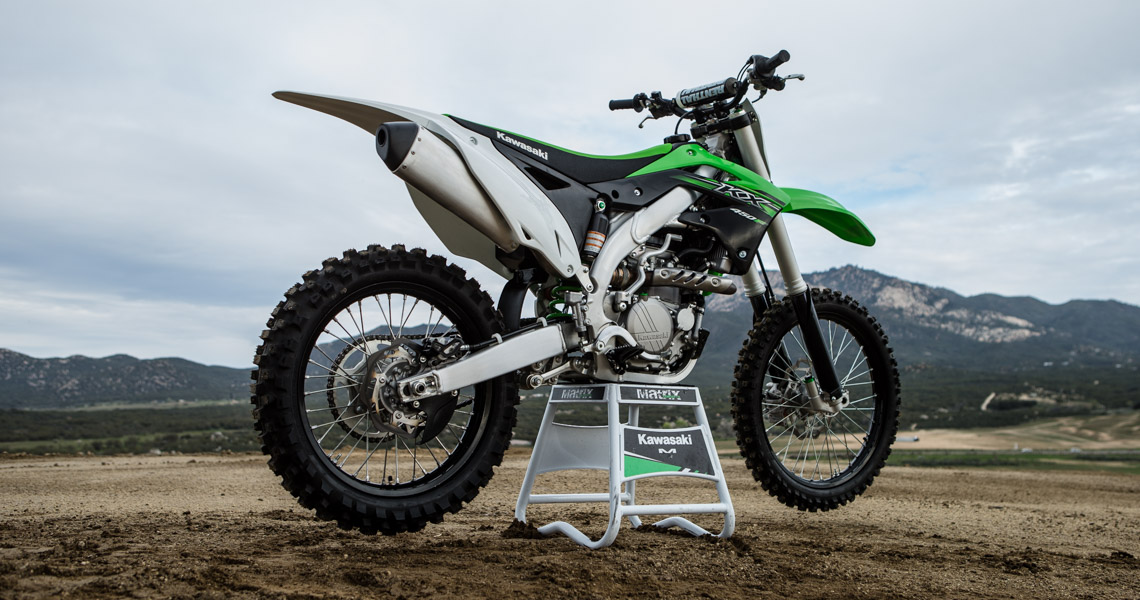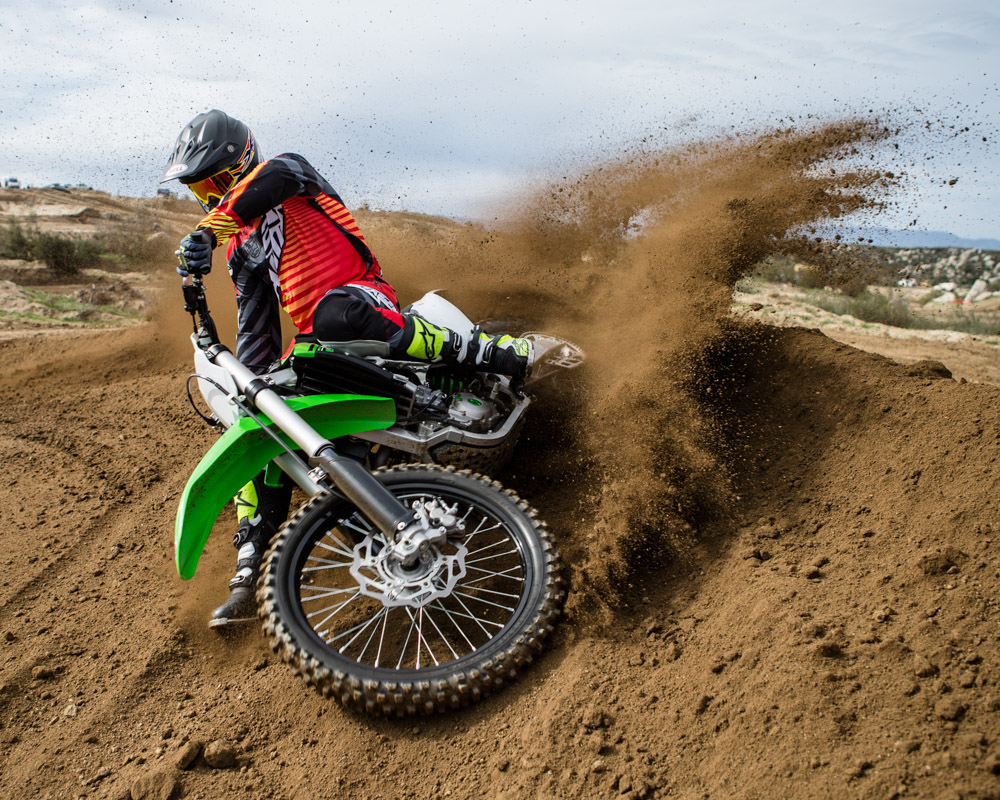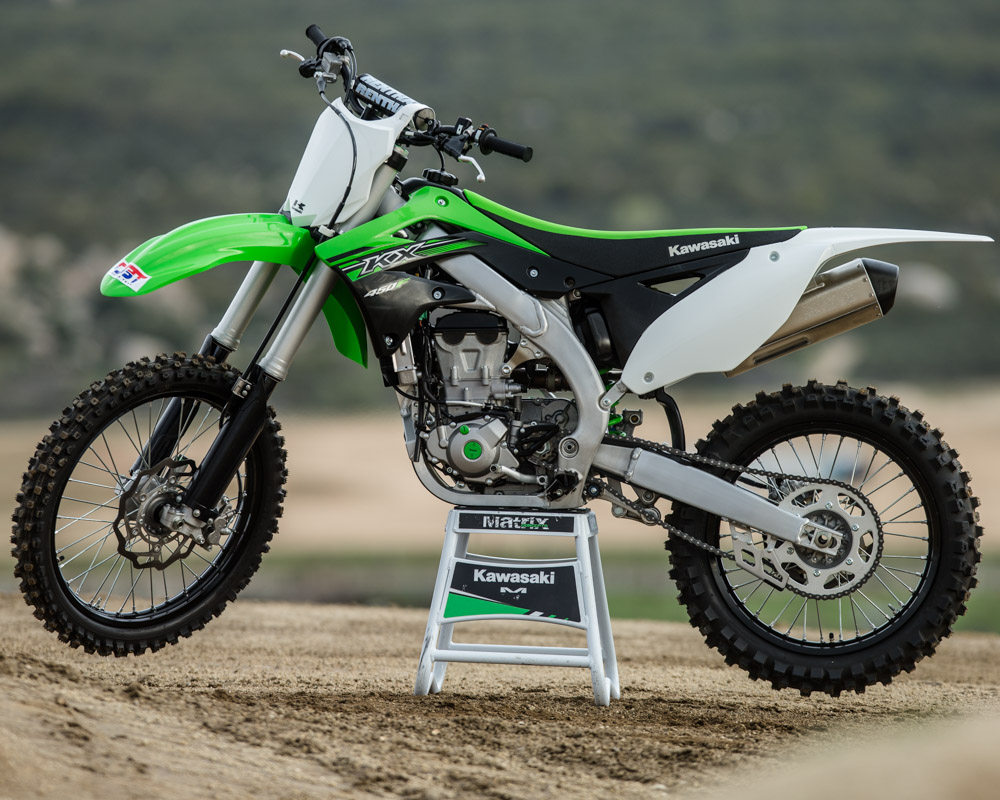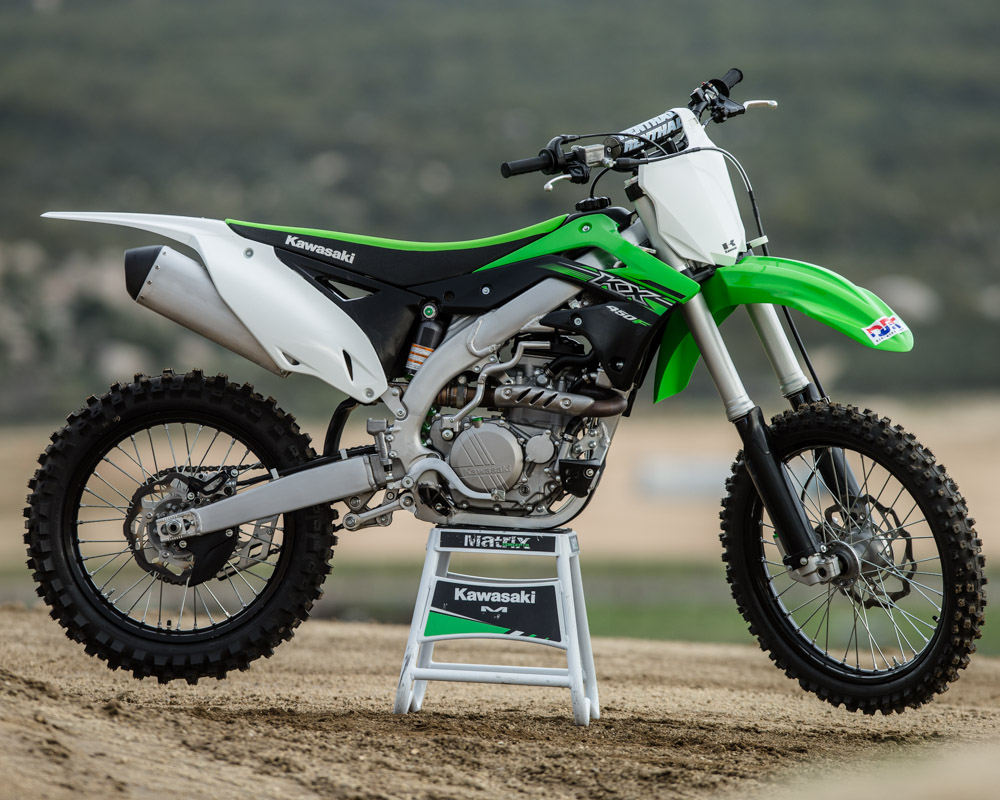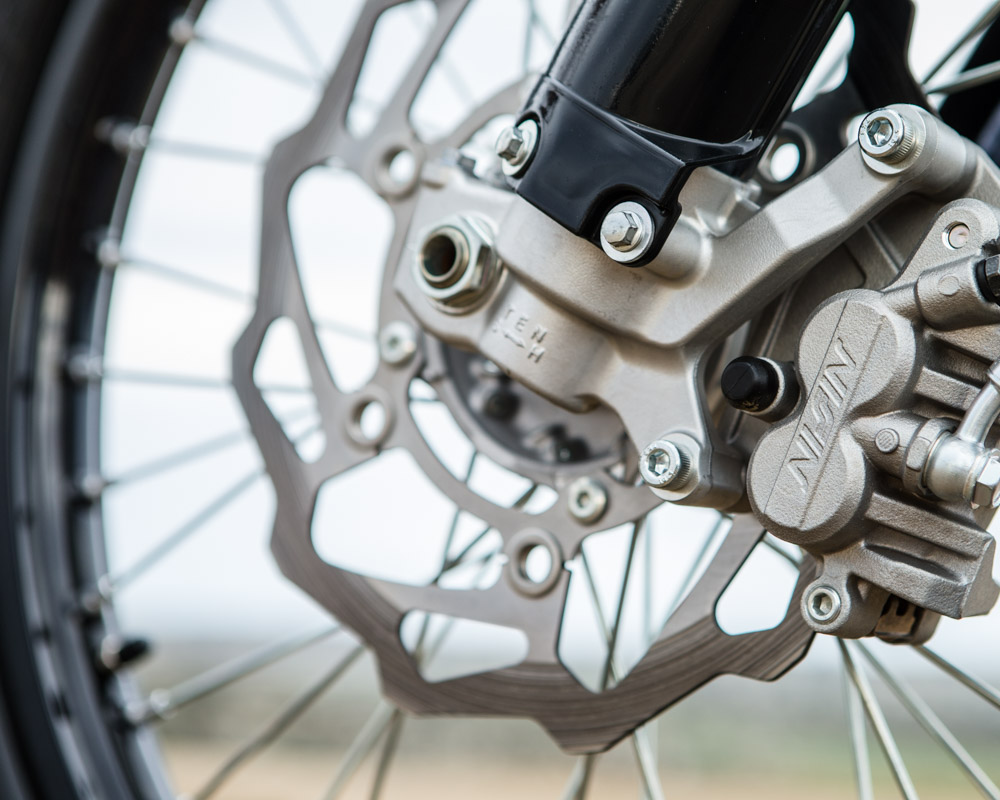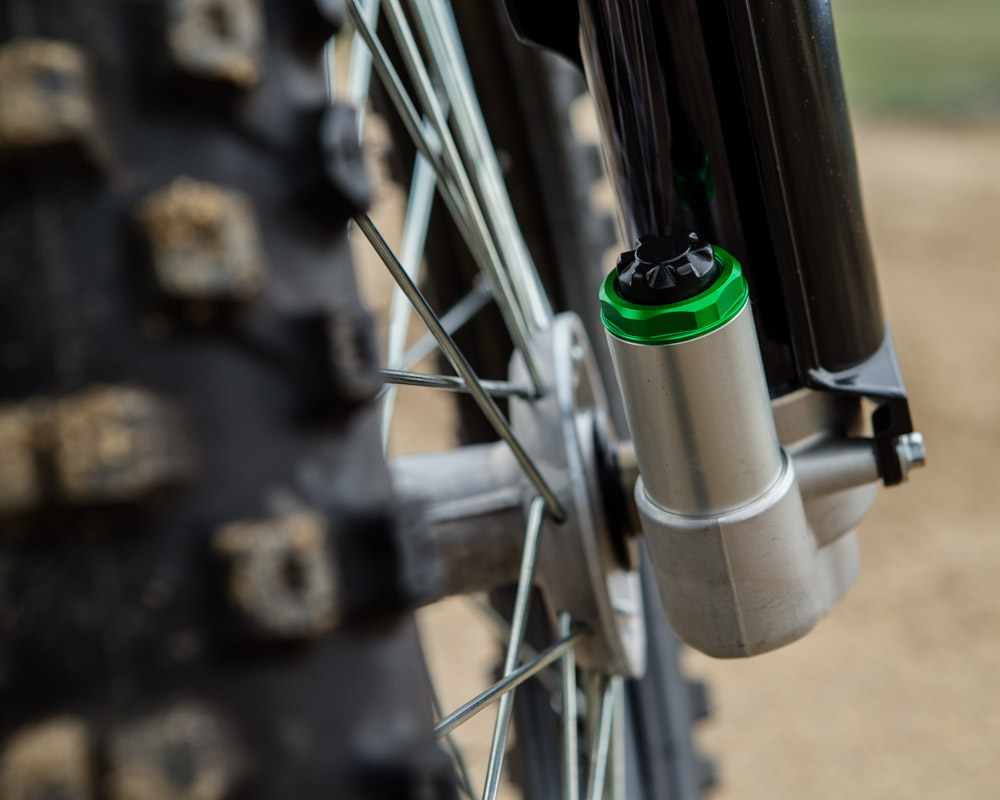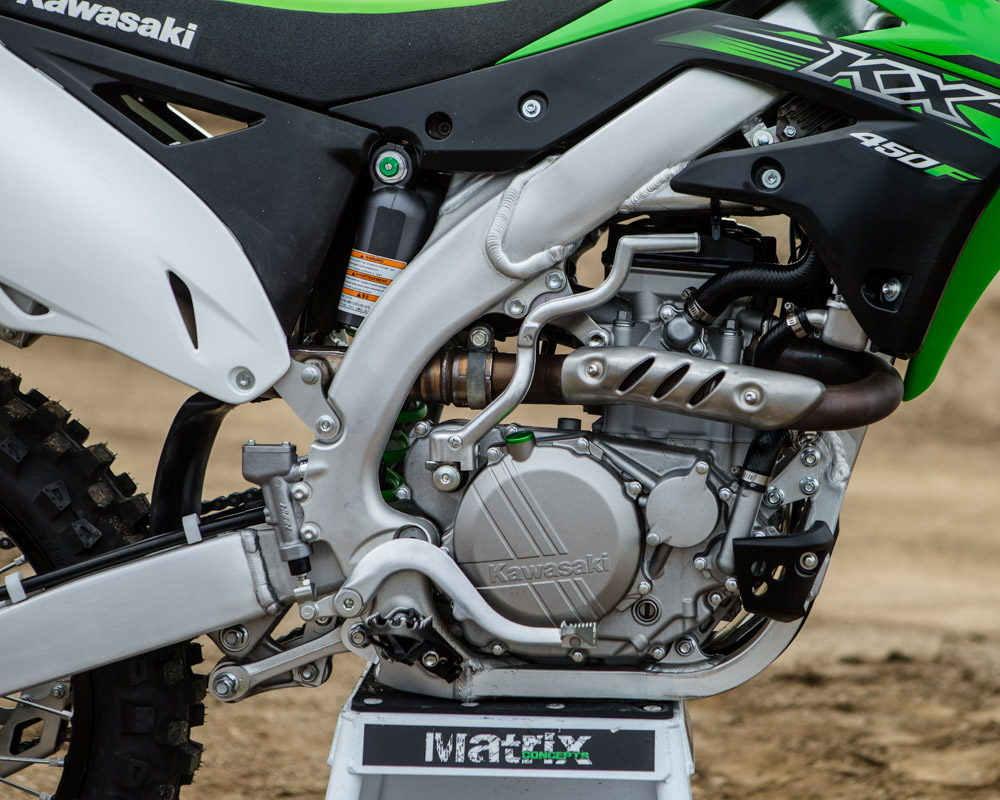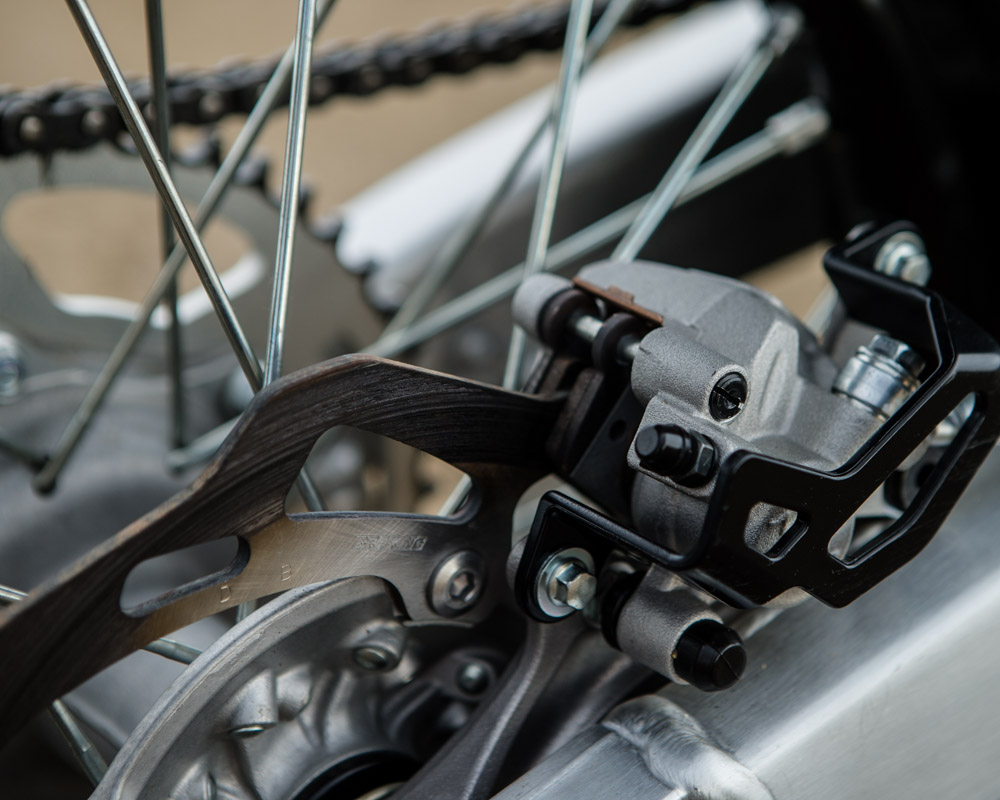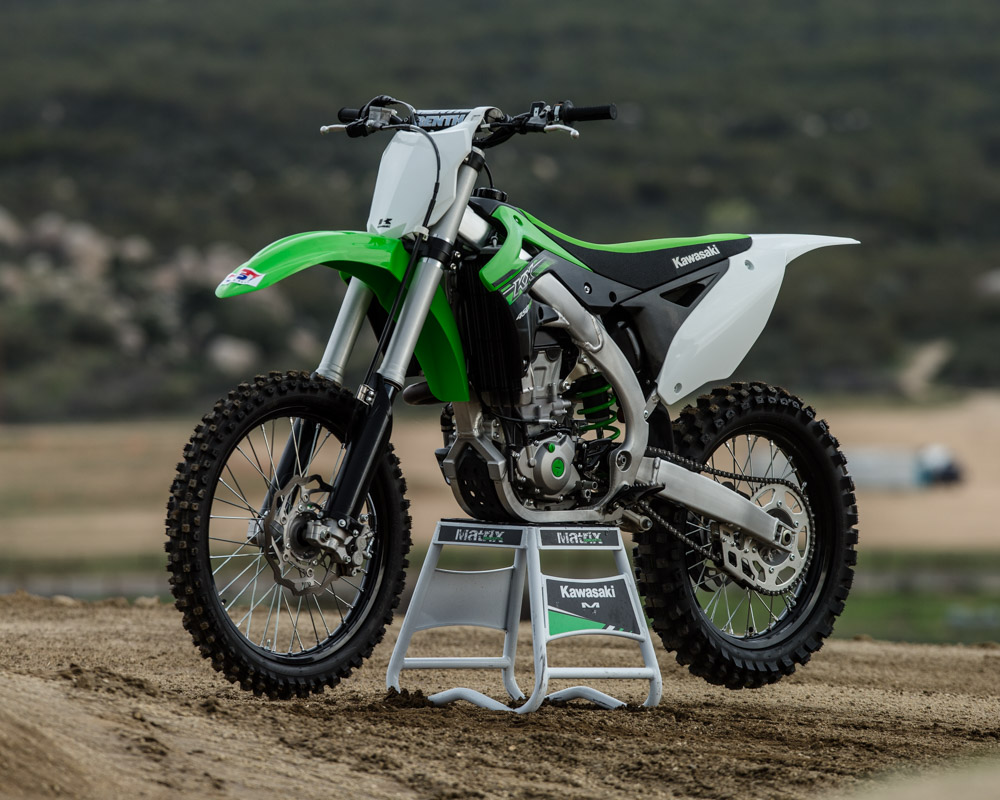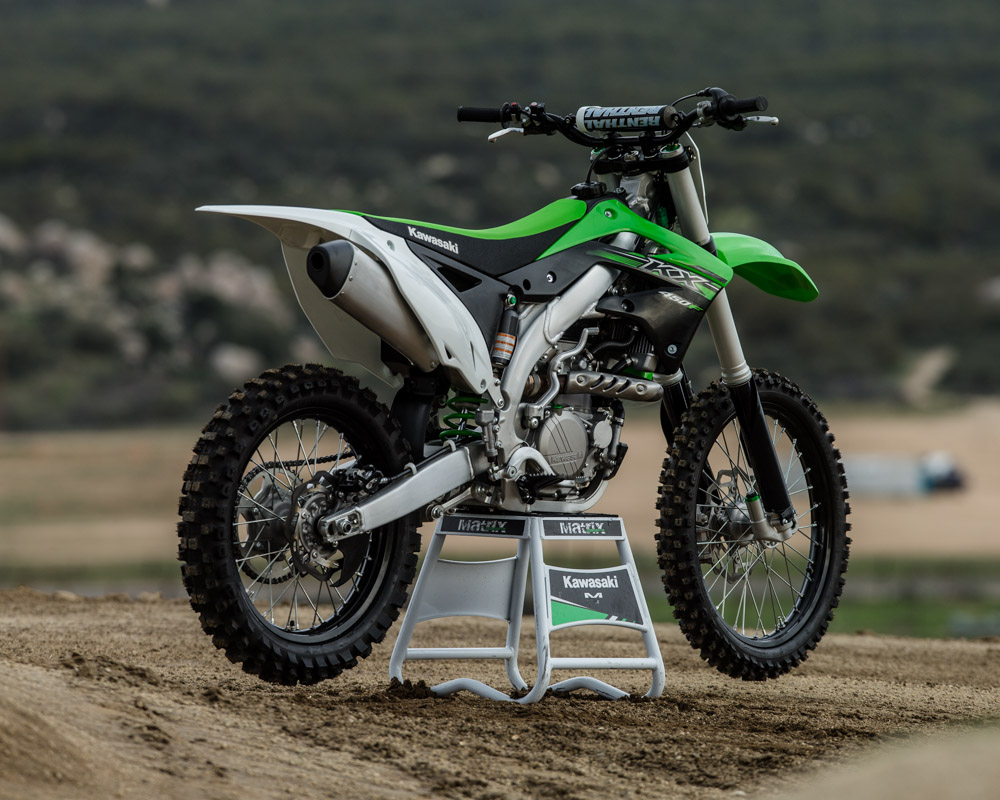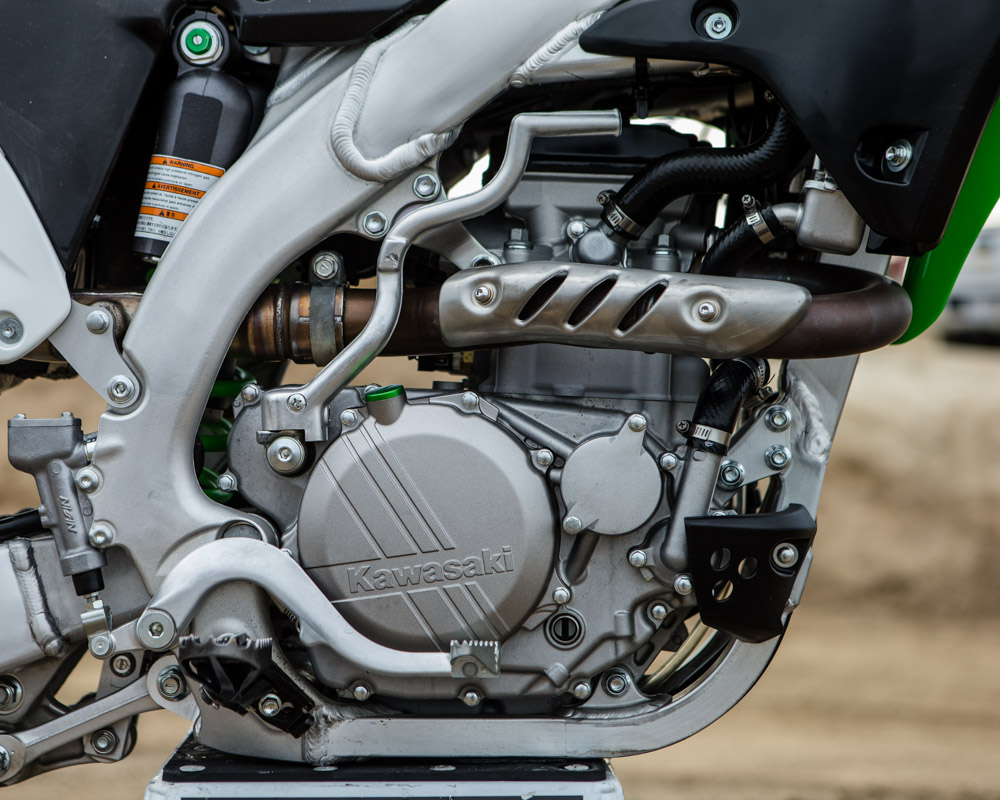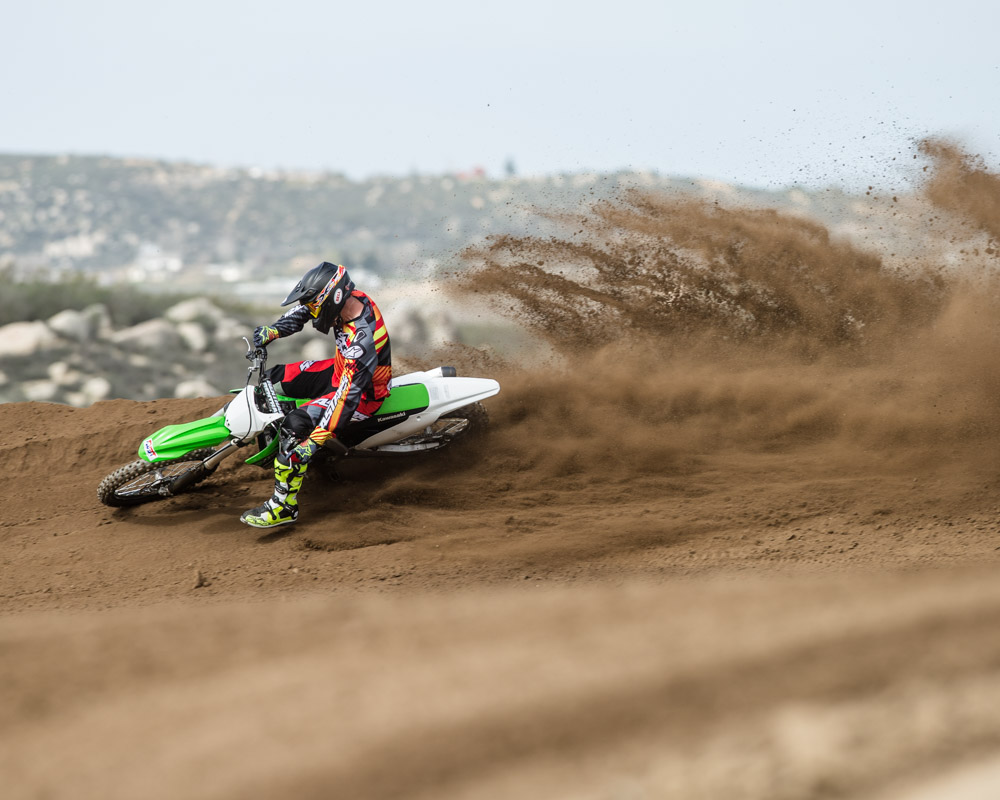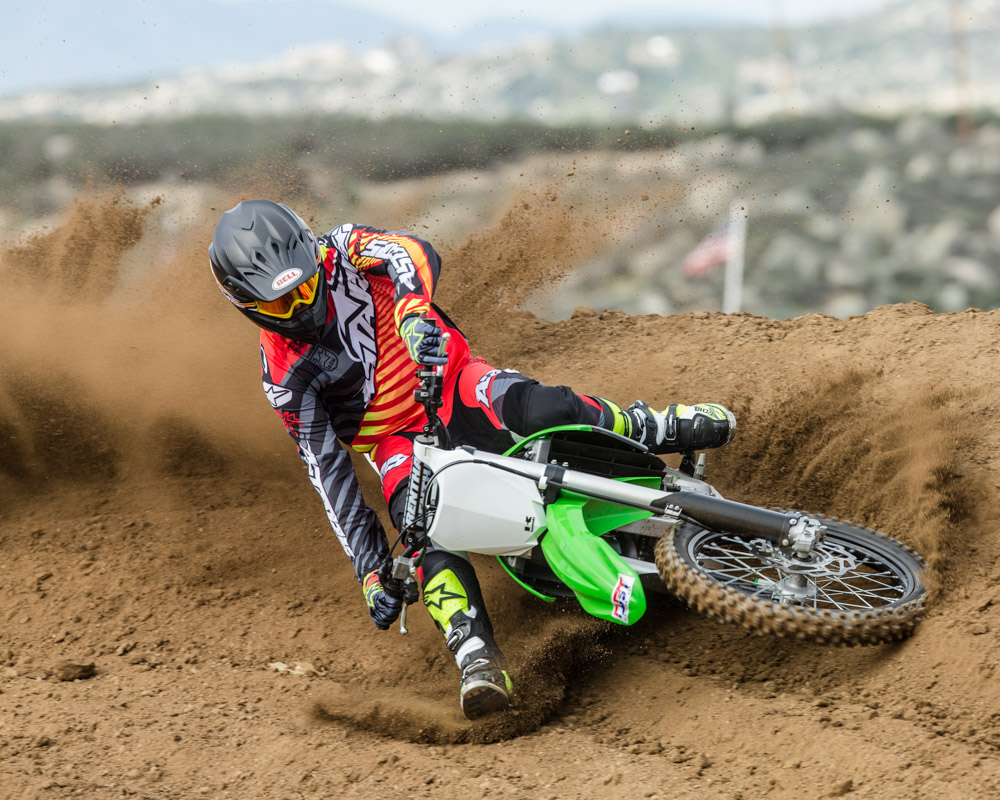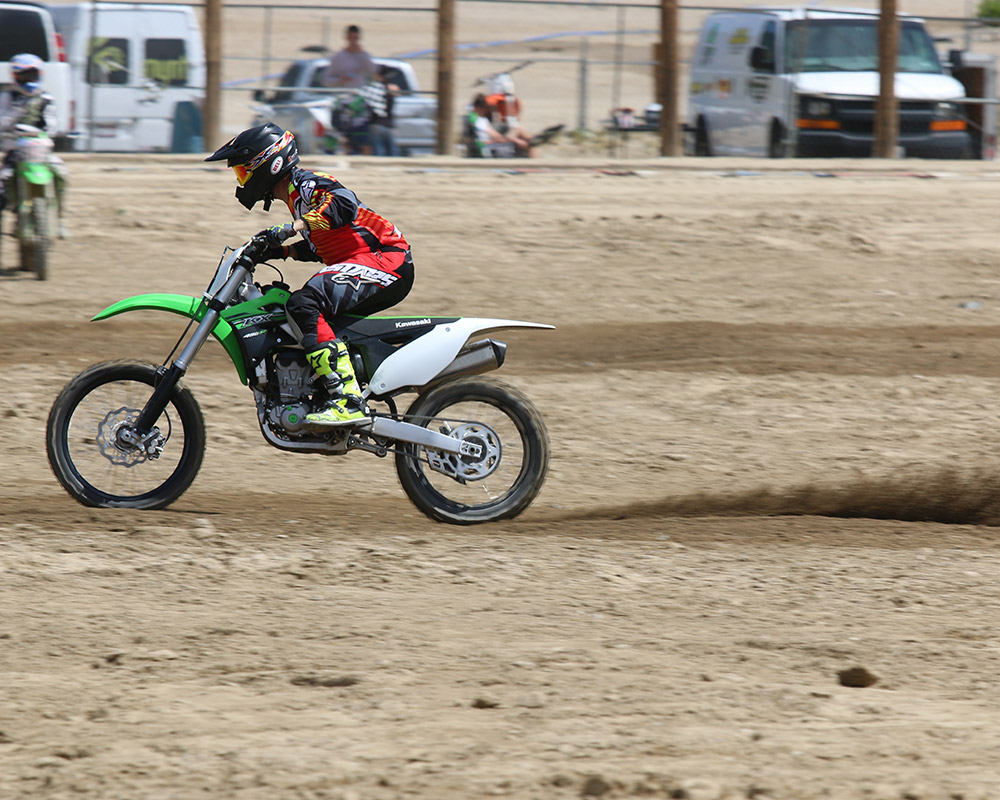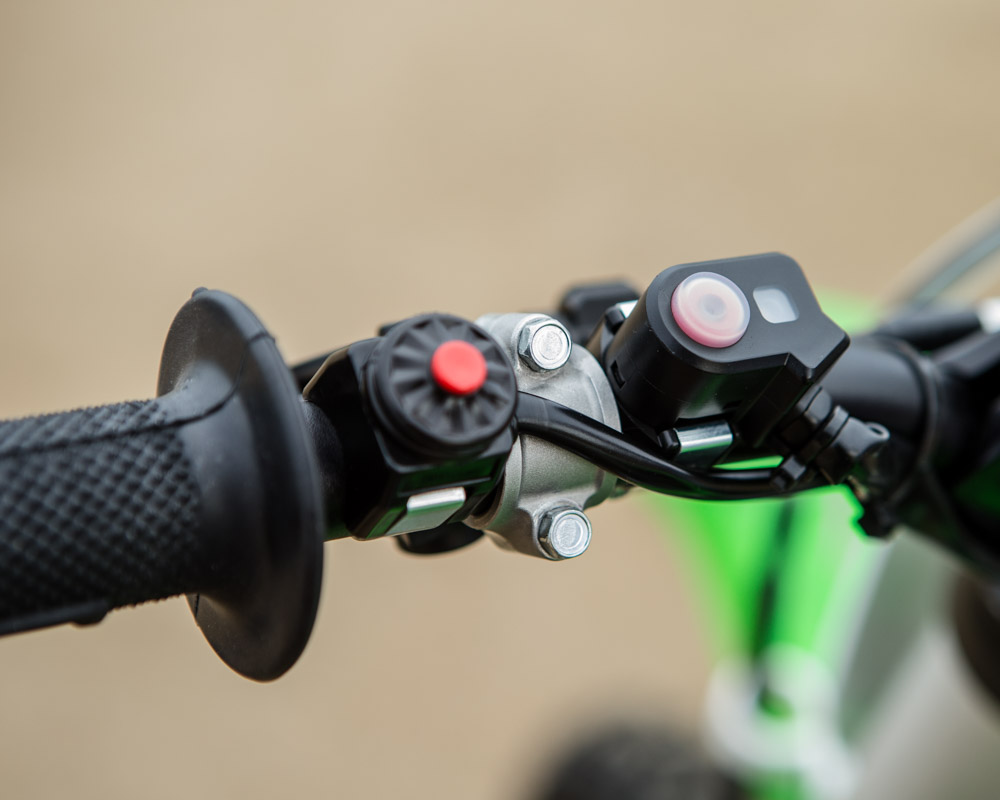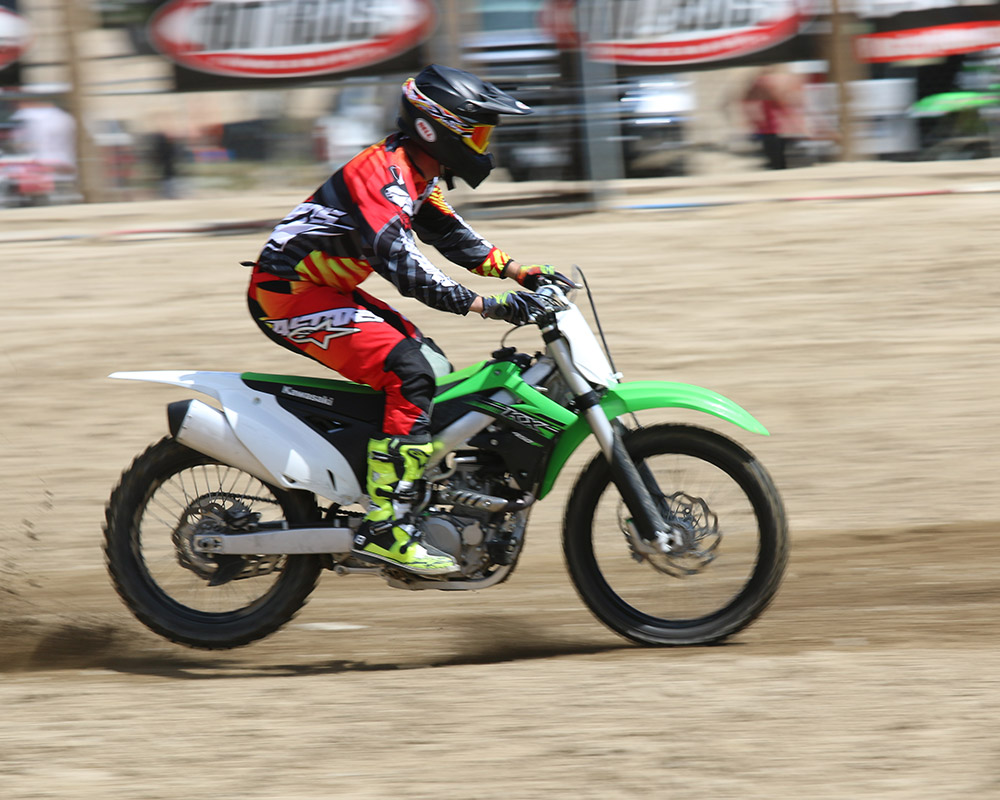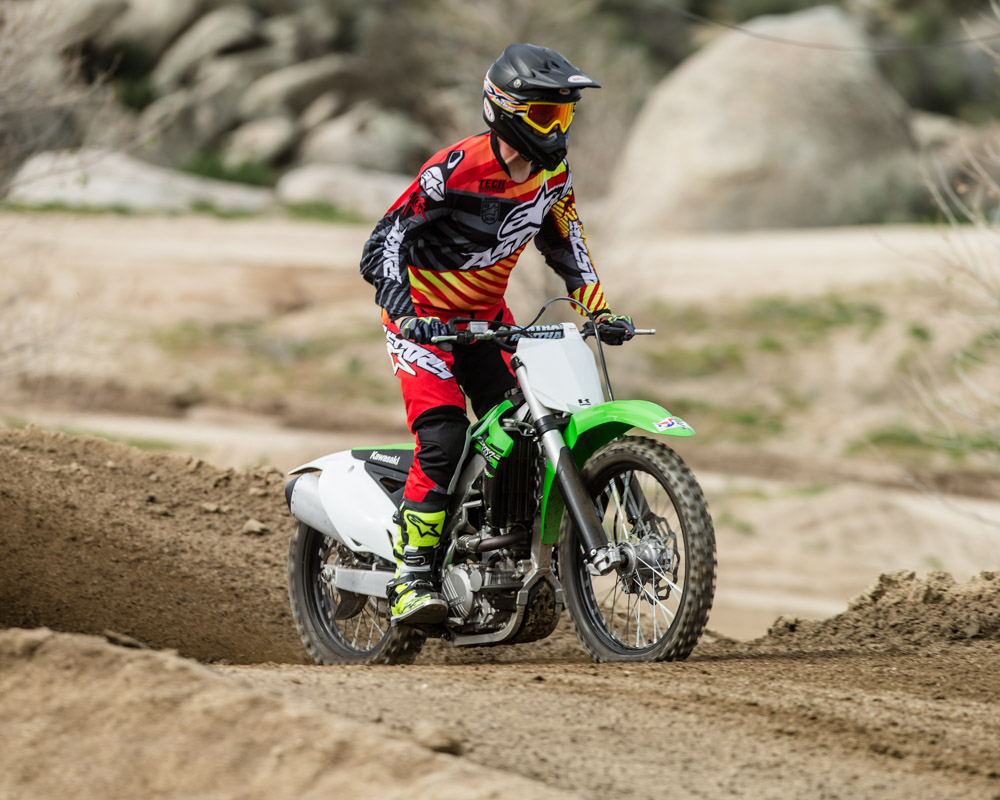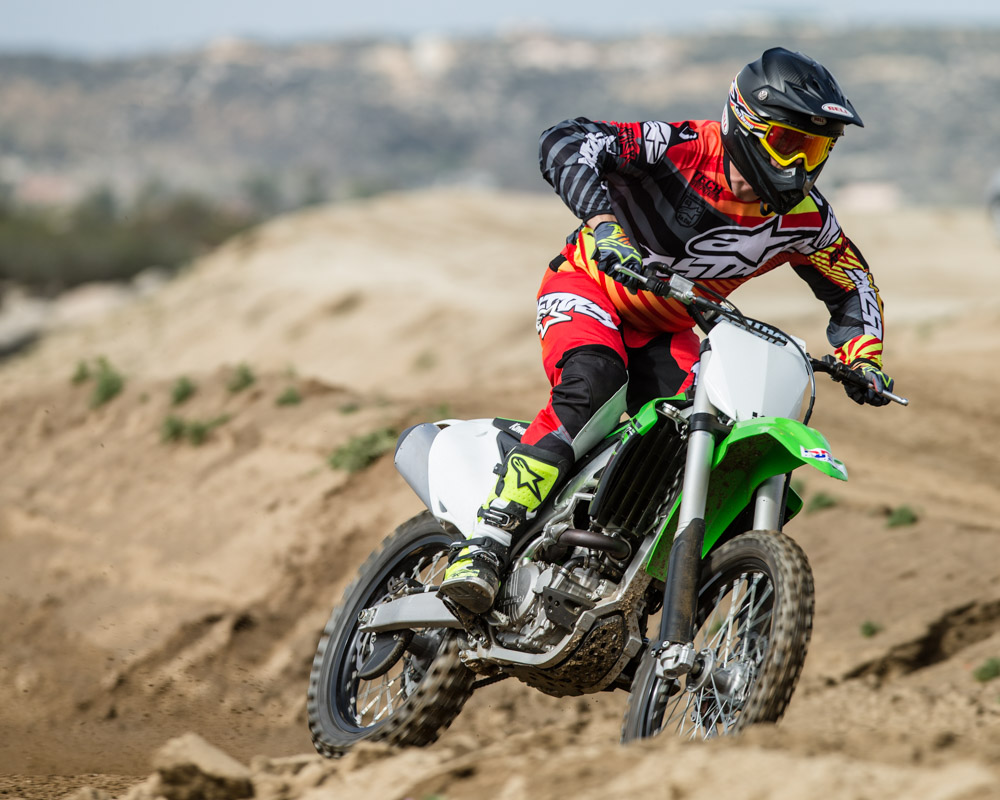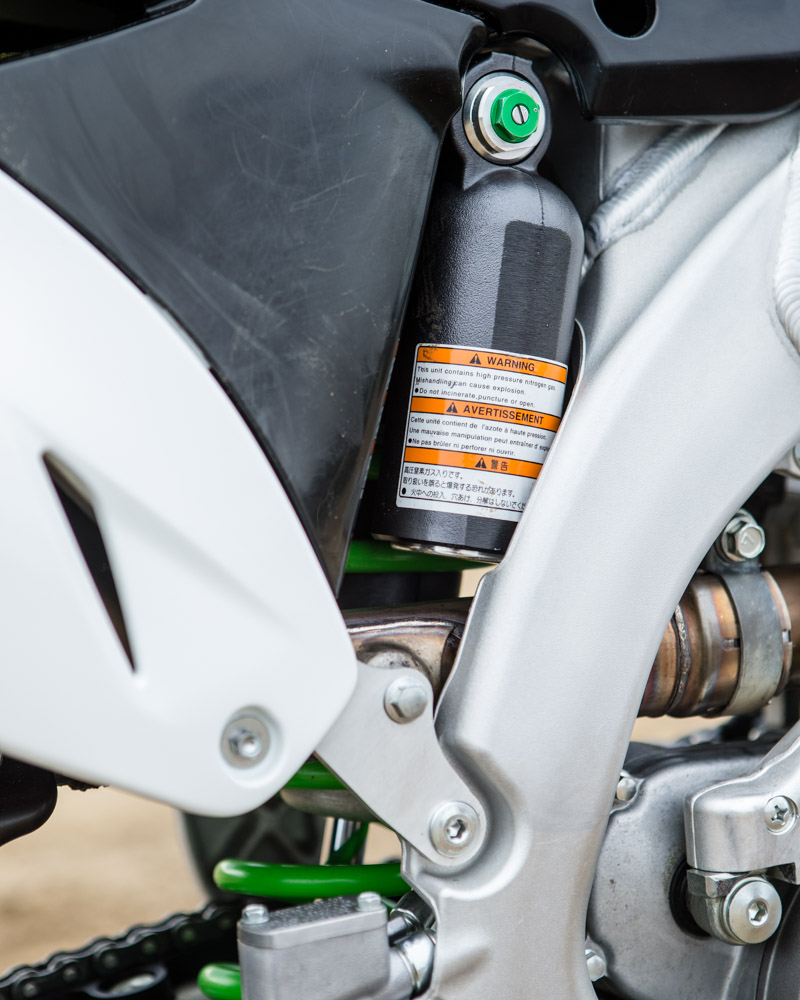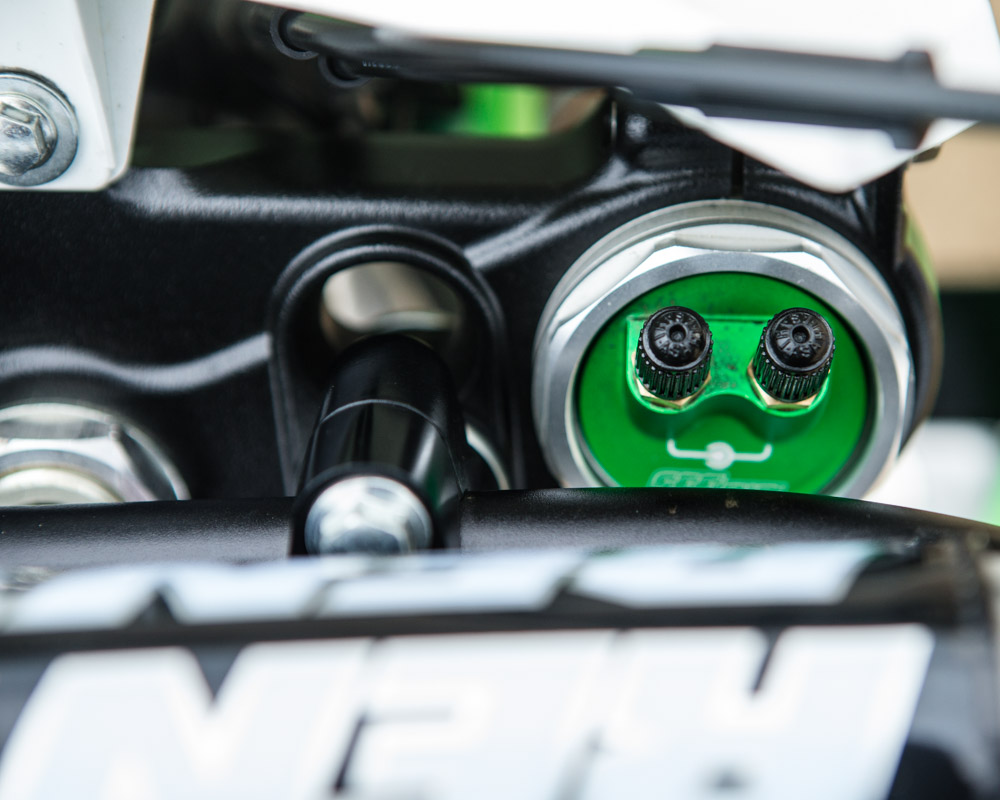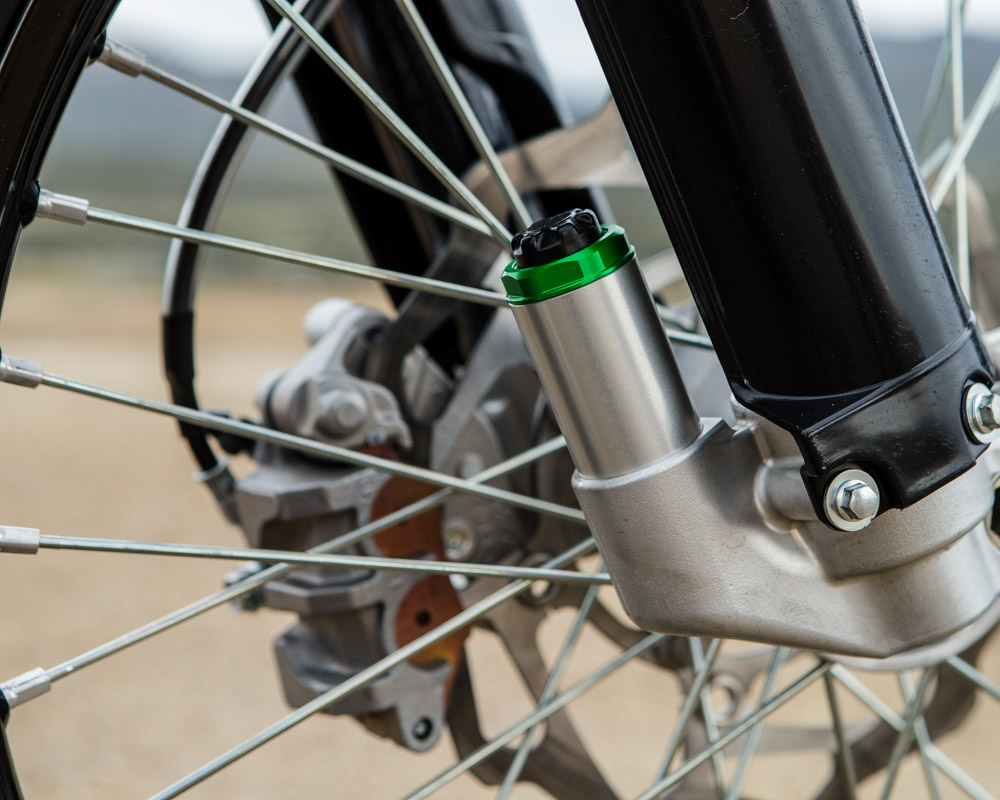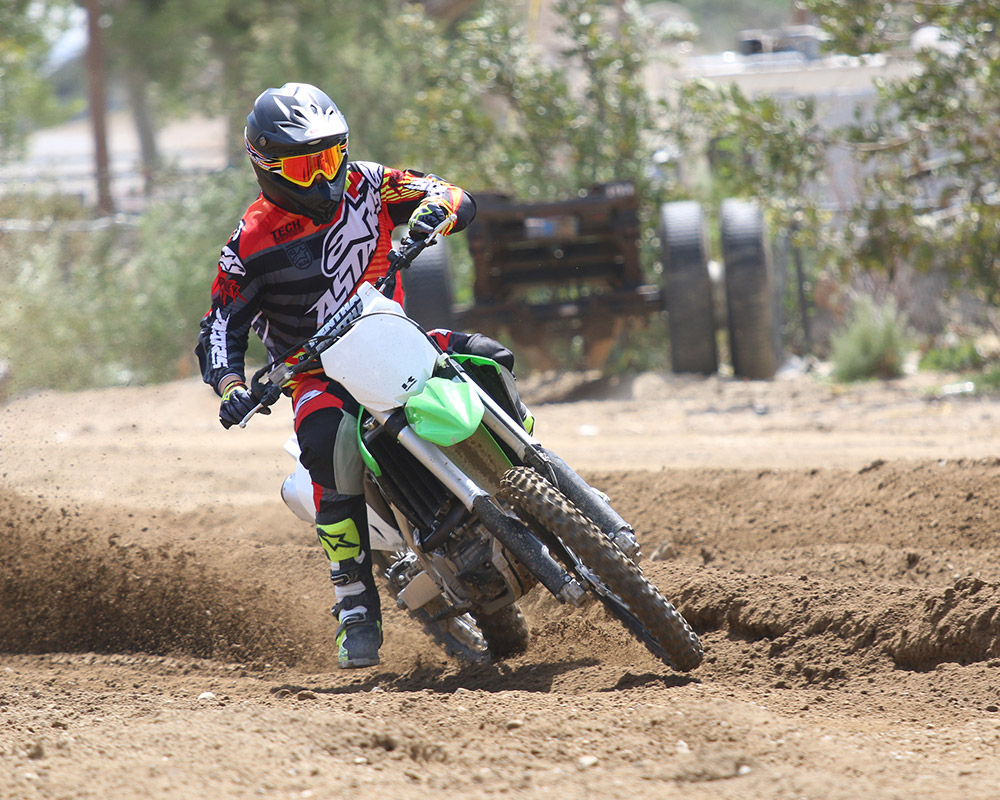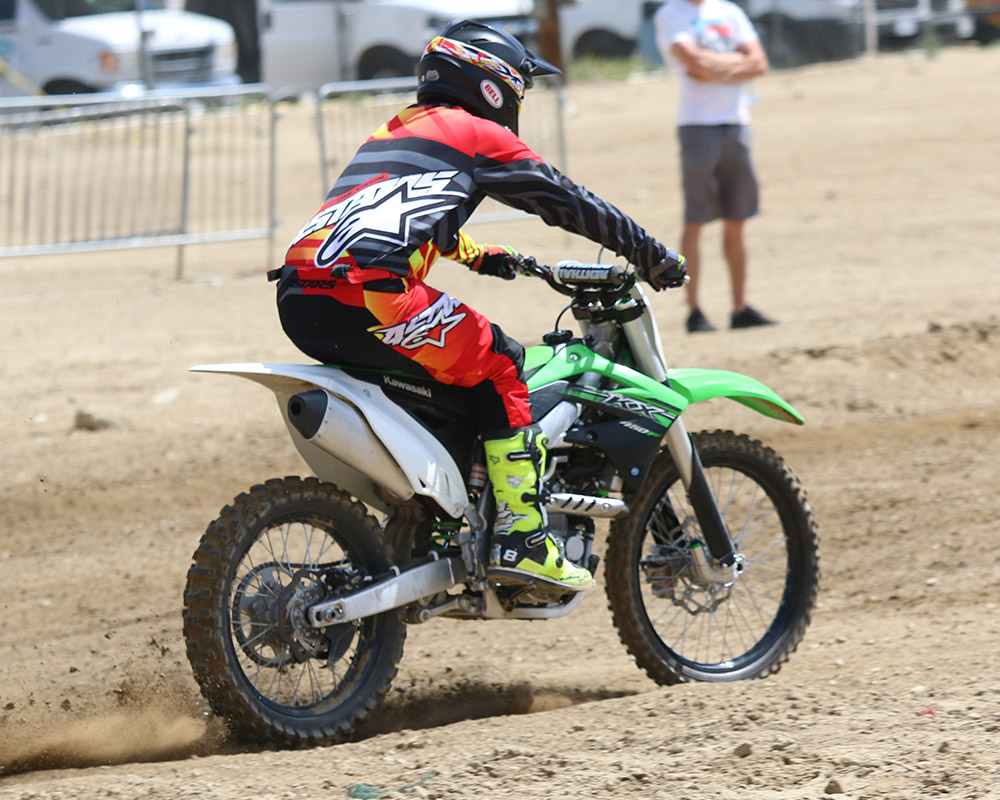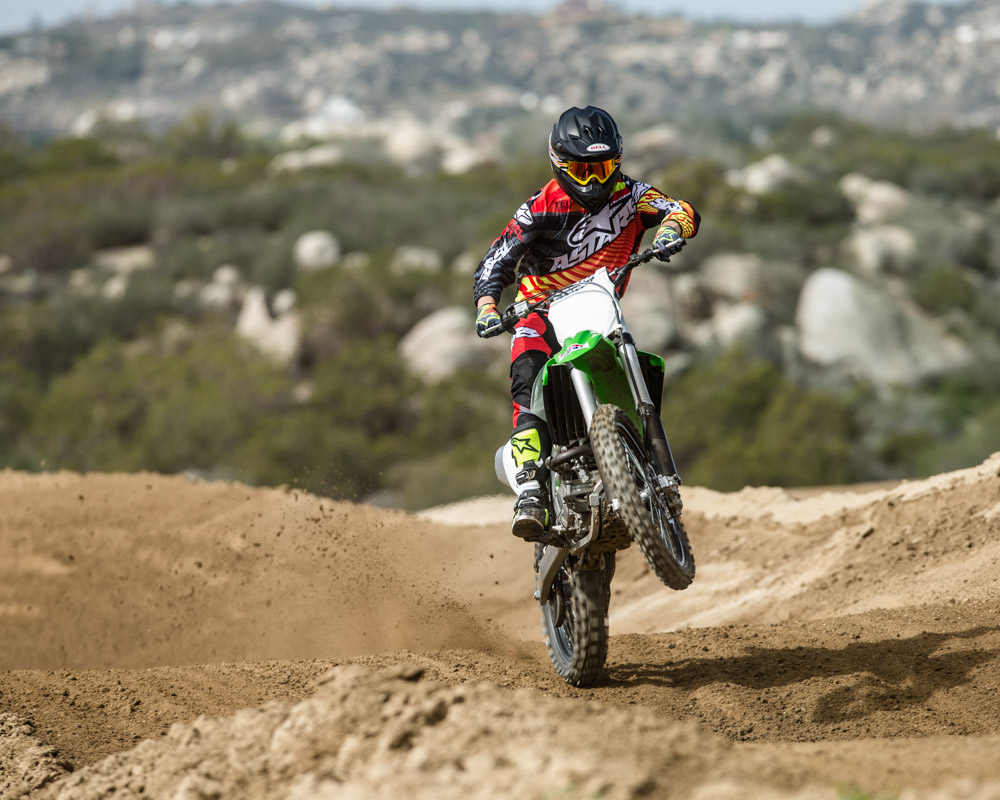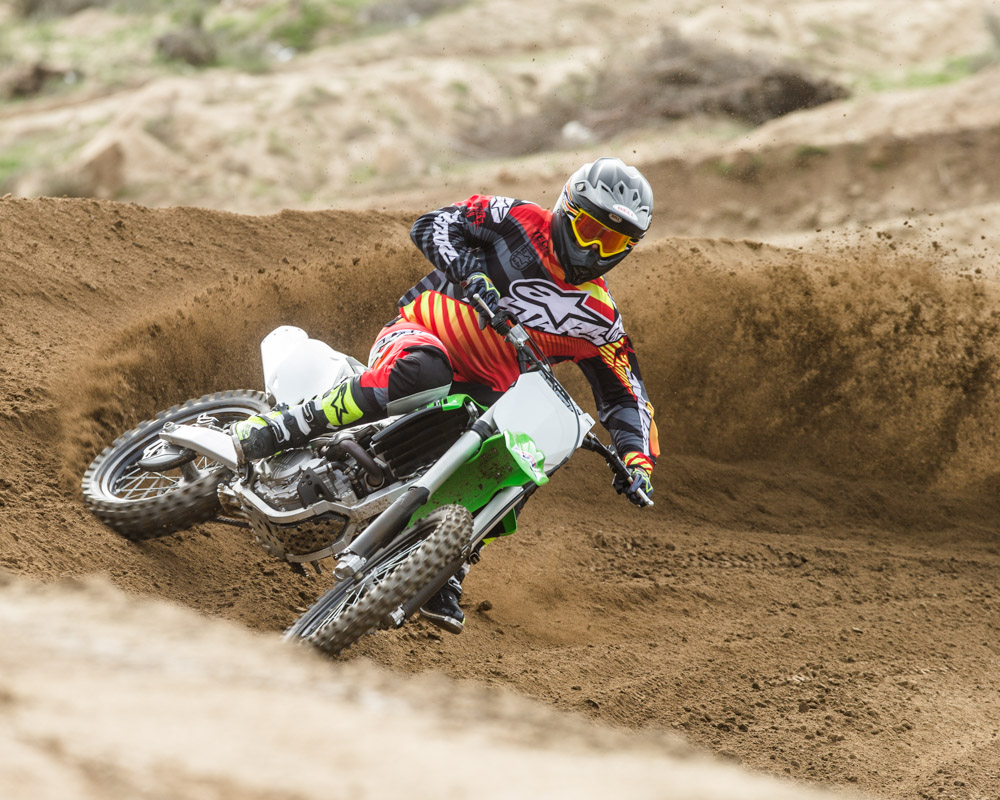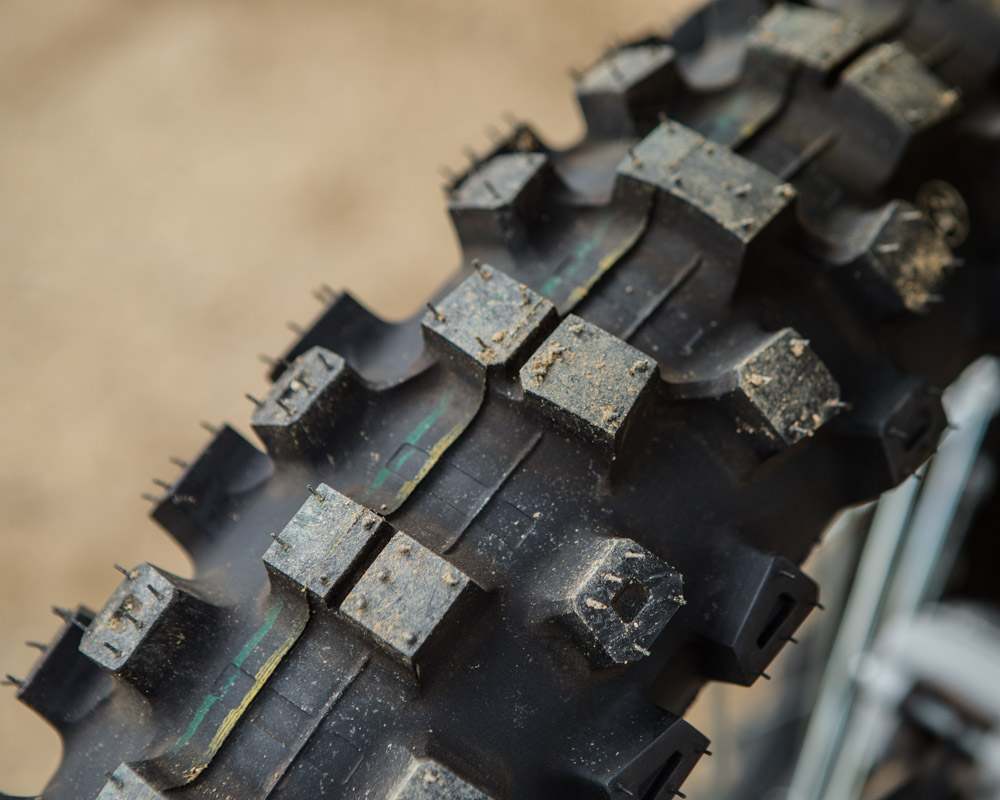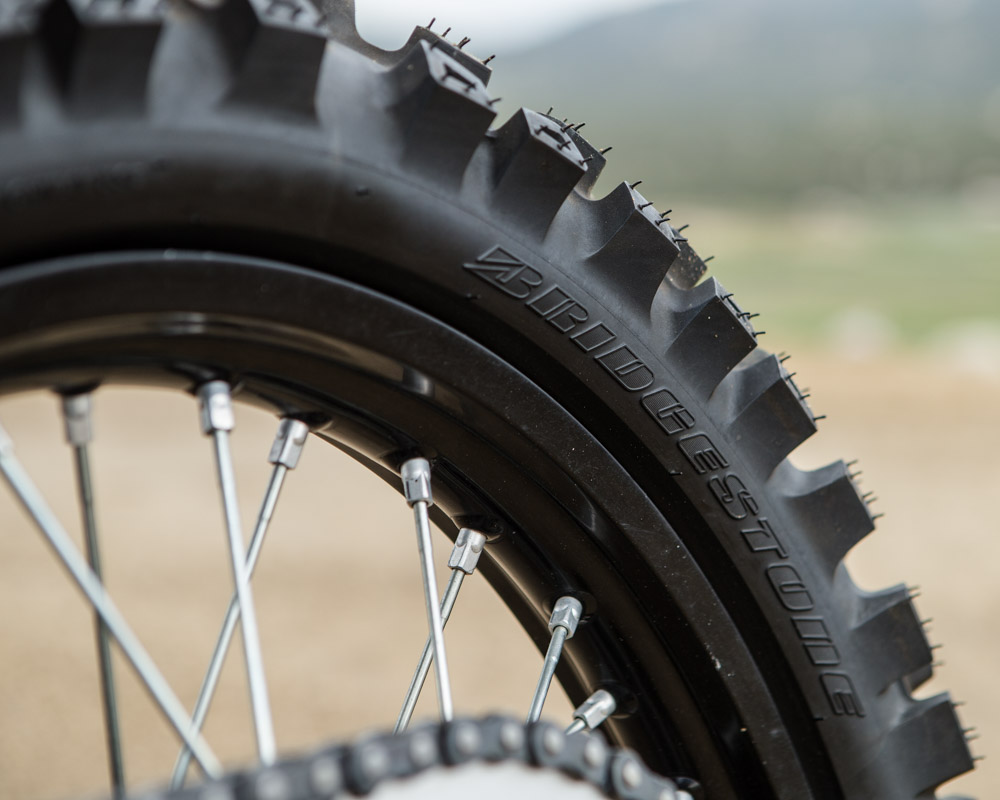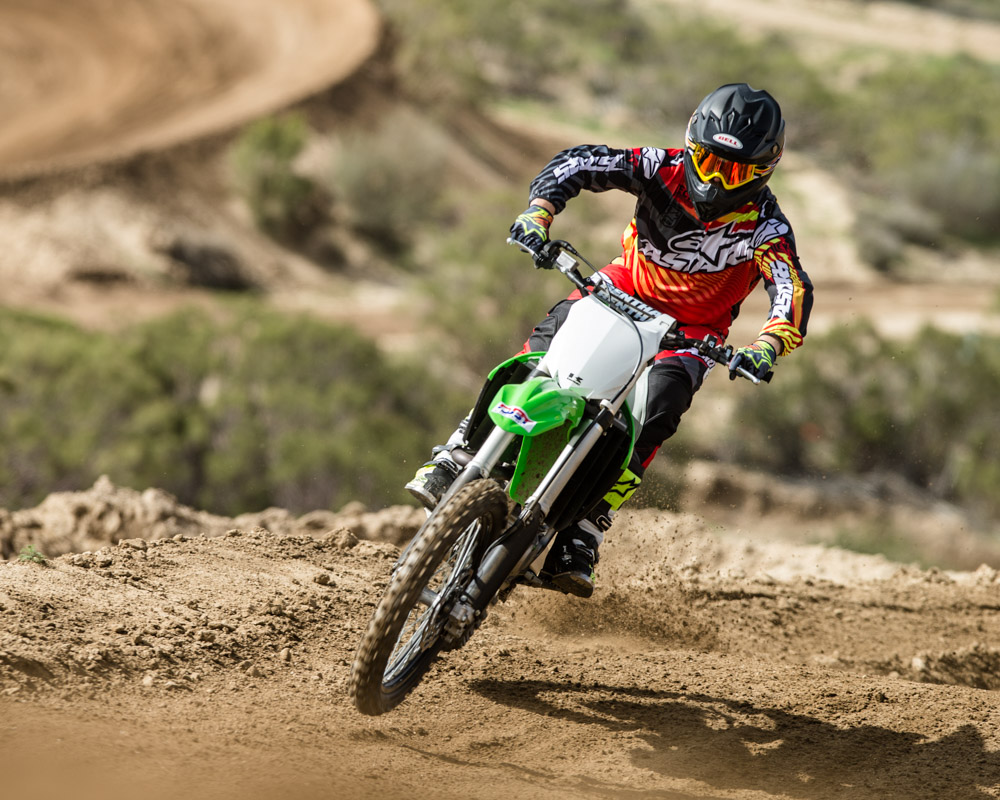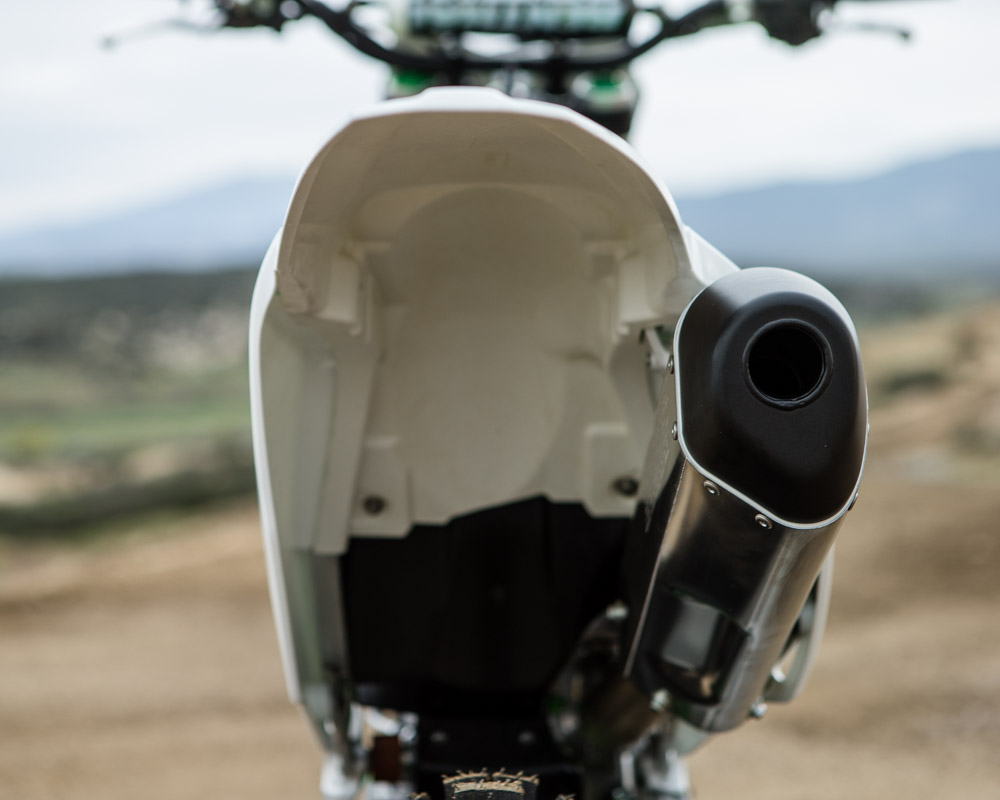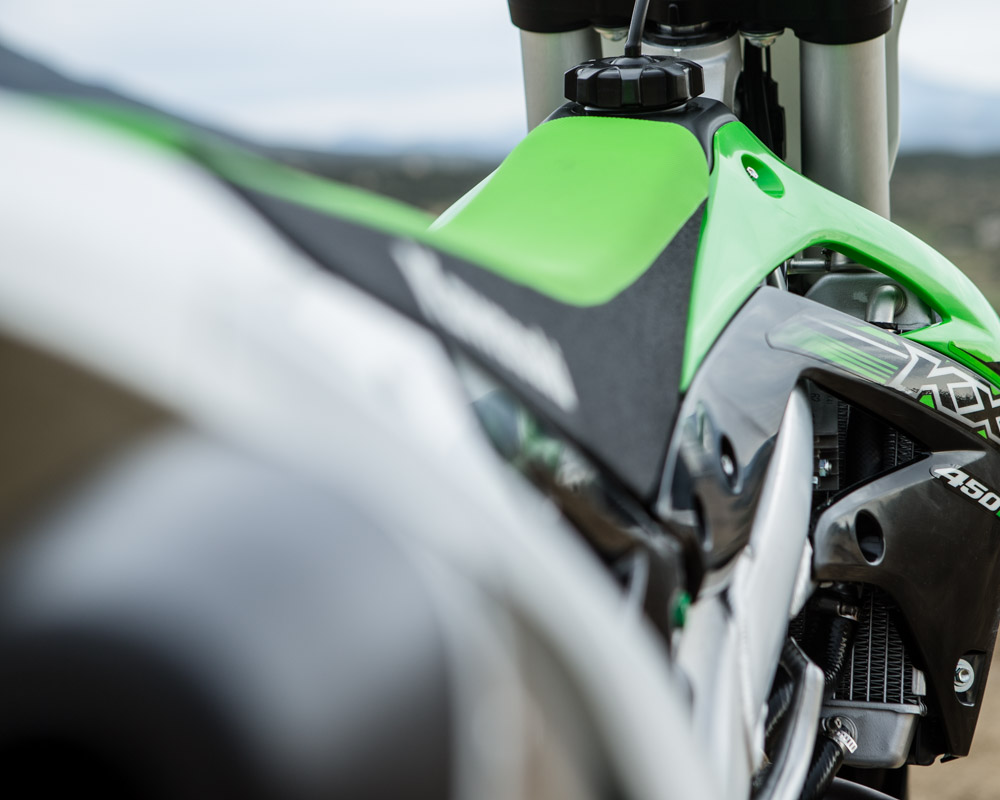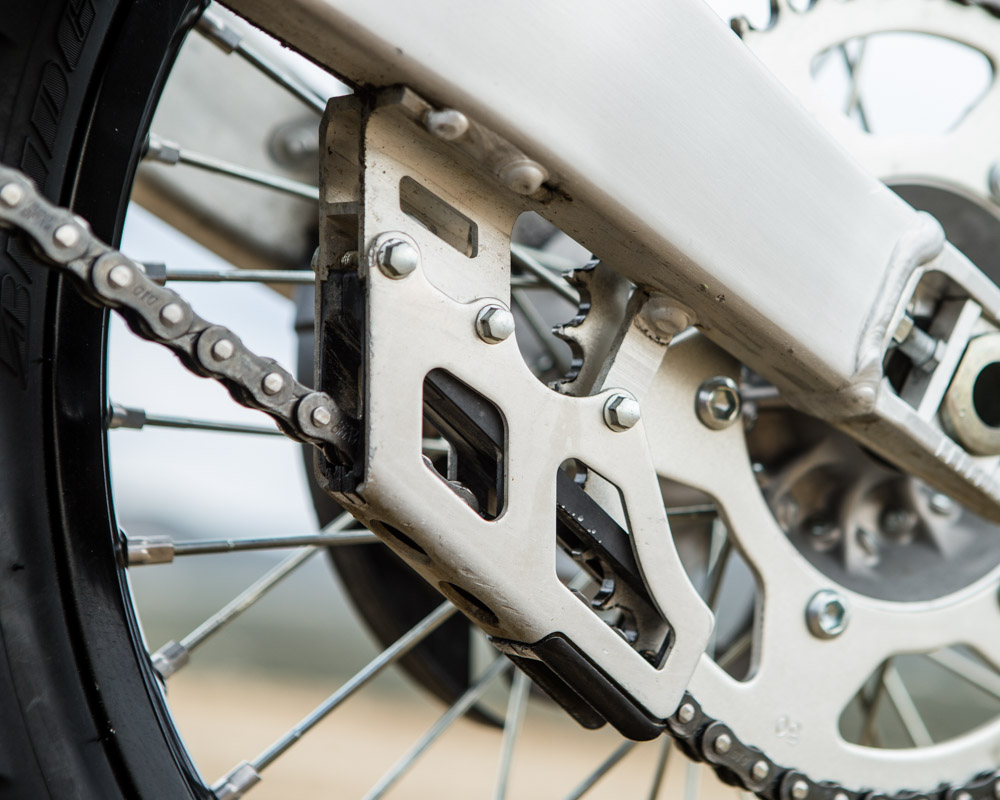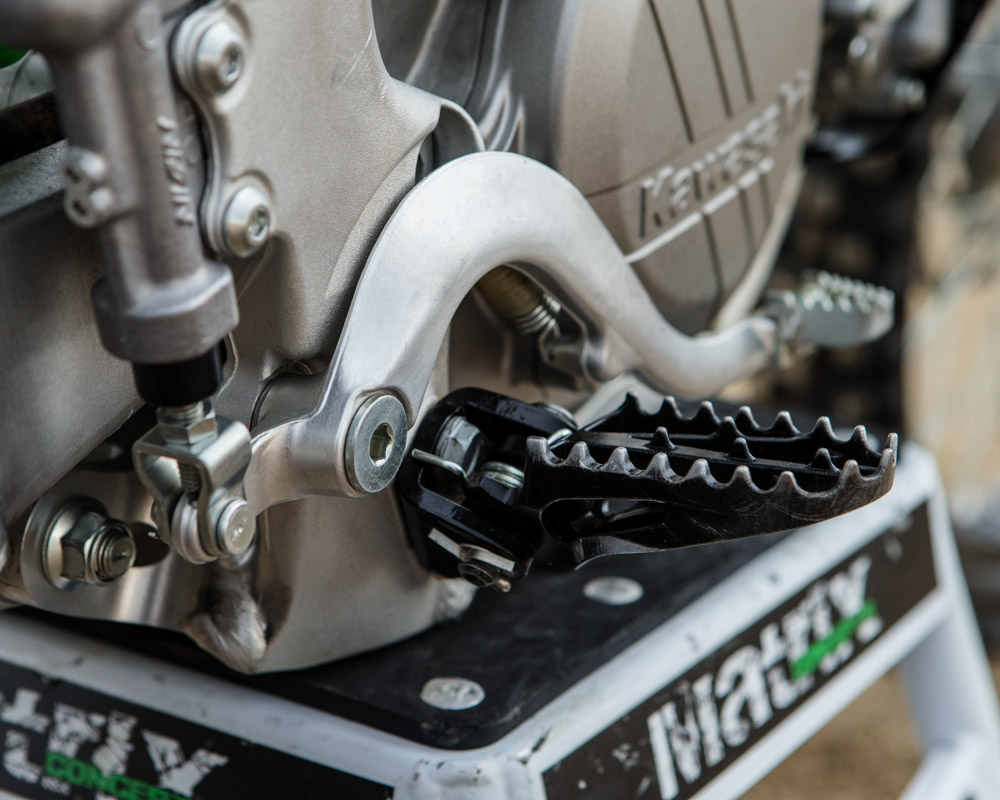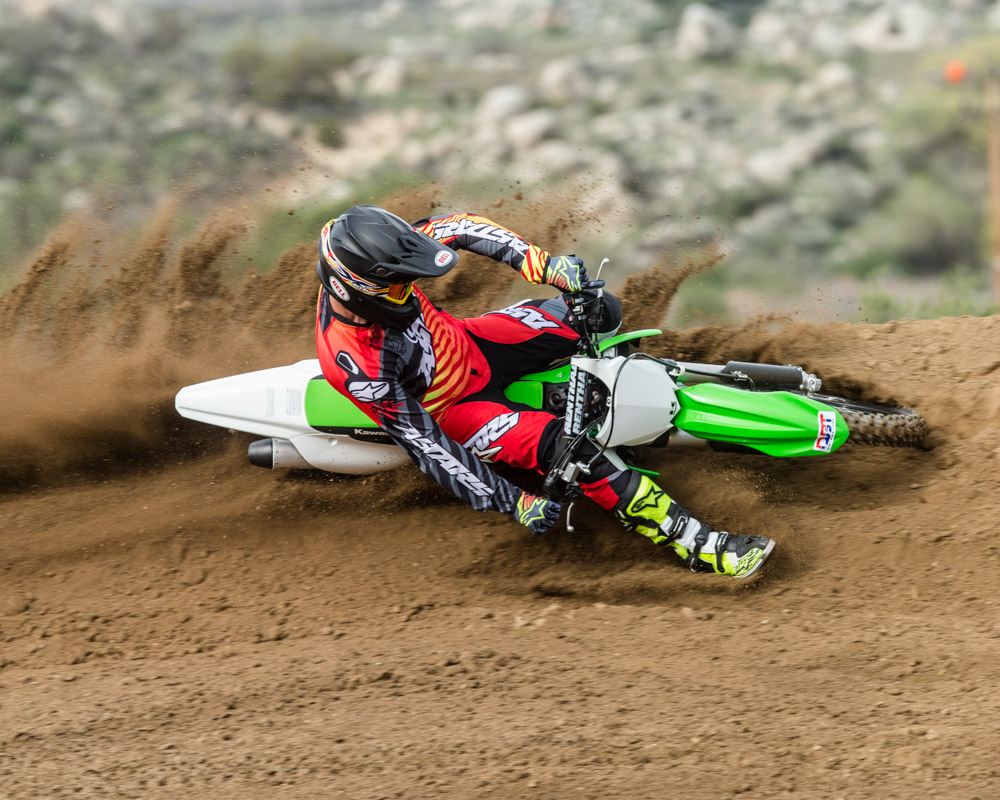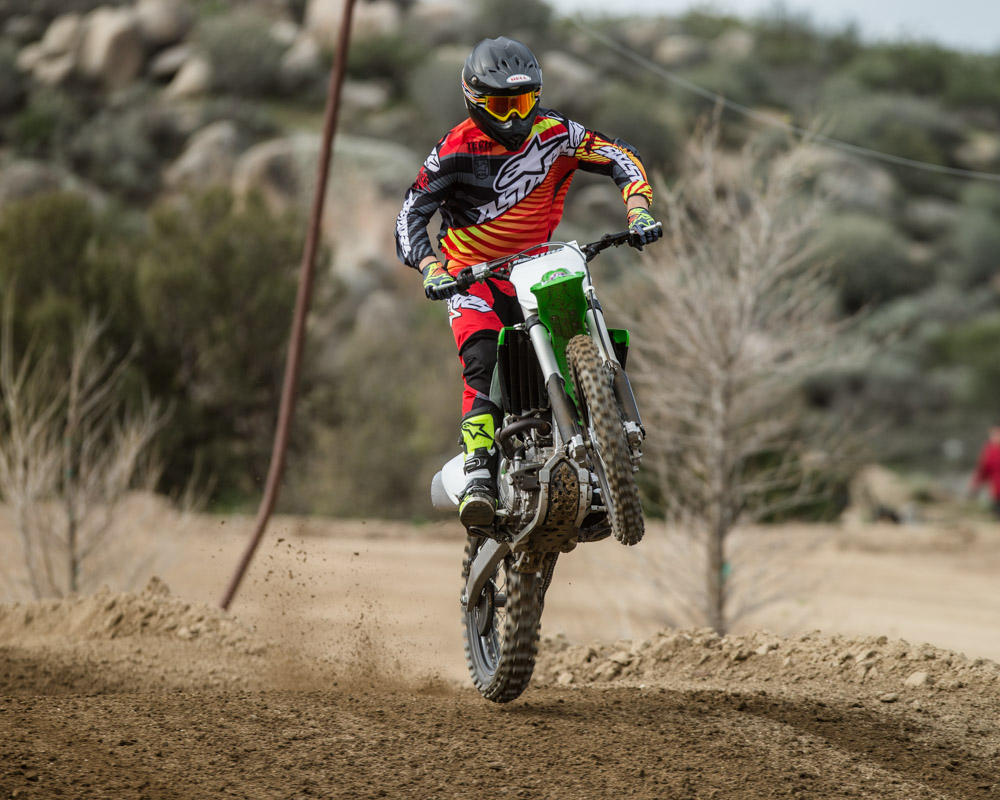2015 Kawasaki KX450F
The King Of The Shootout
MSRP: $8699.00
- The motor produces magical motocross power. It is aggressively elegant.
- If you are a steer with the rear wheel rider, there isn't a better bike on the track.
- Some of the adjustability allows serious customisation to your ride. The KX is super tunable.
- Most riders will never realise the potential of the highly tunable air fork.
- The footpegs need to adjust down and BACK.
- The muffler is full noise at full noise.
Introduction
- This bike has dominated shootouts in recent history.
Over the past five years if there has been a bike that dominated the press with great reviews and wins in shootout or comparison tests, it has been the Kawasaki KX450F. Rightly so. The bike has always had a powerful and potent motor wrapped in a chassis that was comfortable and familiar. Kawasaki has suspension settings that agreed with a wide range of riders and a handling character that was unique but not off-putting. Sticking to their guns, the Green Company has refined the KX450F further and is hoping for the same outcome.
Changes
- Switch to Showa suspension components with the SSF Air Fork
- A slight boost in compression and some ECU changes to match.
- A larger diameter front brake.
Refinement was the name of the game for 2015. Inside the engine a new piston that bumps the compression ratio a bit is tuned with a new ECU setting to match. There are small changes to make the rear subframe lighter as well.
The chassis saw a few big changes, most notably to the upgraded Inverted Showa SFF-Air TAC fork and a Showa shock, replacing the KYB components from last year. The brakes are new petal-style Braking rotors front and rear with the front jumping up to an oversized 270mm rotor for stronger stopping power and control.
Cosmetically the 450 received some green anodized plugs, caps and suspension adjusters along with a green rear shock spring to tune the looks.
Power
- This is the type of motocross power that everyone is jealous of.
- Aggressive yet rideable and easily changed with plug-in clips.
- Not the most power on the dyno but try feeling that on the track. This bike is fast.
The KX has never felt like it is hurting for power and the 2015 bike is exactly the same. Its motor rips. There may be other 450s that have more HP when strapped to a dyno but on the track Kawasaki has something that all the others are searching for. It blends instantaneous throttle response at any RPM with an aggressive pull that somehow still gets great traction when you want it to. It feels aggressive, acts aggressive and can be as aggressive as your right wrist wants it to be but at the same time remains very rideable.
The feeling of the motor is very free revving and barky. There is also minimal compression braking especially when coming down from very high RPM. The clutch pull is light and has plenty of feel so using it to compliment the power, by either boosting or reducing the output is an easy thing for a rider to do. Combined with a five-speed transmission the KX can run in two different gears on any part of the track since the motor’s spread is plenty long. It will chug effortlessly and pick up when needed on jumps or out of turns or on the other side rev and make crazy power but not get heavy feeling with the RPM. We won’t say there is any one part of the power that stands out because it is all good. The transmission is average in its shifting and will let you know if your oil is getting bad or if the clutch is getting worn as that shifting performance will fall off.
The bike starts about as easy as a kickstart bike can and it’s exhaust tone at an idle and rolling through the pits is actually quiet. In fact the crazy thing is the KX passes a stationary sound test to a DB meter just fine. But on the track the bike has a barky and raspy noise that is loud to those hearing it--even if it is closer to normal sound levels for the rider. Another thing the KX does it make a loud pop from the exhaust at odd times, usually in off throttle in the air or just as you get on the gas without a load. It seems to be unburnt fuel in the exhaust getting a burst of air to ignite it.
The KX comes with two optional couplers to change the ignition and fuel maps. One aggressive and one for lesser traction conditions--one richer and one leaner, depending upon how you look at it. They make small changes to the delivery and a rider should really test them out as they do alter the way the bike feels. Oddly some of our riders preferred the aggressive map when the traction was bad because it allowed the bike to more easily pull a taller gear. Similarly when the traction was good, the less aggressive than standard or soft map allowed more aggressive throttle use without the hit of the aggressive map. Additionally the Kawasaki ECU is completely tunable and you can even log data with the company’s tuner but we did not feel the need. Kawasaki really know and understand motors.
There is even the launch control button for starts and here again you will have to play with it and learn how and when it will help your starts. Depending on traction and rider styles it can help or hurt. But it does something, it is just realizing if that something is for you. If you need more than this 450 engine offers you might need to get an agent to work out your racing contracts too.
Suspension
- Though adding air to three separate chambers on the forks is a task, the adjustability is pretty infinite.
- A very balanced package and better than previous KXs.
- Standard settings are decent and getting it perfect for any rider just takes time.
- The pump you need comes with the bike.
The switch to air forks has been a big taking point for all the manufacturers and also a make or break in bike comparisons of late. Kawasaki was one of the first adapters and continues to stay on top of the game with the Showa SFF-Air TAC fork, from the KYB air fork of the last two years. The rear Showa shock runs through the Uni-Trak linkage system and for all purposes is very standard or traditional.
Simply put the Kawasaki suspension is very good and highly tunable right out of the box with standard settings. And Kawasaki includes the proper air pump so you can get the 150 PSI and above into the forks if needed. And yes, like tire pressure and knowing the ride height on the bike (which is directly related to the fork’s pressure) you need to check it before every ride. If this is too much (and we know it is for some, even others writing reviews on bikes) then you will never realize the advantages of an air fork. For the most part we were very near standard settings most of the time and added/removed either air or clicks of compression and rebound to tune the bike for faster or slower riders. The one exception was we were advised and always ran 18-20 psi (Up from recommended 7-8 psi) in the outer chamber of the fork which seemed to hold the front end up better and aided in bottoming resistance which became excellent. With the air fork the methods and options change and become more complicated but this is a high-end racing machine and riders want the same components and performance as a factory bike, now you have it.
Having the DLC coating on the fork helps with stiction (and air forks feel terrible pushing on them in the pits) and in seal durability so that is an advantage the KX has. And since very little of the main air spring is in the external or outer chamber there is a very low likelihood of a collapsing failure.
How good/tricky is it? Well on a smooth vet style track with safe and not too aggressive jump faces and landings the shock didn't need any tuning and we found having a little extra air (135 psi up from 131 psi) in the balance chamber of the three chamber fork helped the feel of plushness. Our faster pro liked 155 psi up from 145 psi in the main air chamber of the fork which would be equivalent to going up a spring rate in the fork.
Going to a very rough and choppy outdoor Glen Helen, all riders dropped the air in the main chamber from the smooth track setting. The slower the rider the more compression was clicked out of the left fork as well. And the more choppy the track was the more air we added to the balance chamber to get the fork to move easier when it got smacked. All along the rear shock gets a click here and a click there but you realize that it isn't quit as tunable as the fork and we have learned its limits. Even taking advantage of tuning the high-speed compression, it is there and available to use, but since the air fork has come on you can do more with the ride height of the bike through the front end now. For 2015 the shock seemed to have better progression and better bottoming resistance to match the fork. And if the shock felt bad, especially in the mid stroke we found that that balance of the bike was off and it could usually be fixed with a little ride height tuning through either shock preload or front fork pressures. You can even move the forks in the clamps as well. Taking notes and learning will yield results, trust us.
Air in the right fork leg not only allows the changing of the theoretical spring rates but the additional balance chamber also allow you to alter the feel and to some extent the position where the fork becomes stiffer. In conjunction with the left fork leg now having more room to deal with hydraulic damping the clickers really do work too. And if you can’t get the fork to work for you one of a few things is going on. You either don’t understand it, you didn't take the time to try different things or you didn't really try. Once you learn the steps and the feel of each it is easy to pinpoint the proper step, if you are that sensitive or feel the need.
This is the best suspension a KX has come with and it is all up to you to take advantage of it.
Chassis - Handling
- A rear-steering slice your way around the track kind of ride.
- Not the lightest bike but it does not feel as heave as the scale says it is.
- Better brakes take some time to get used to, they are stronger and more aggressive.
The KX is not a small feeling bike nor is it cramped in any way. The layout is very neutral and most riders say it goes right down the middle when compared to other bikes. Far from being fat the lines and colors when sitting on the bike just do not give it a thin and nimble feel. Also at a scale weight of 246 pounds full of gas, it is not the lightest bike in the class either. You can feel the weight when moving the bike around and even to some extent when riding on the track. But all the talk of numbers and feel do little to clarify how the KX feels so well planted on the track and yet very loose and agile at the same time.
One of the outright advantages the air fork has brought to the KX is the lighter feel it gave to the front end of the bike and the lightening of the steering. This on a bike that also has the trait of being a “slide and go” turner. It really likes the rider to spin up the rear end, kick it out just a little, get the front end light if not just off the ground and rocket out of the turn. This is a character that takes a complete package of correct power and a balanced chassis to accomplish. In the air the KX isn’t feathery as some bikes but it is lighter than you think a 450 should feel. Again, the nimble front end in relation to the rest of the bike gives a light sensation that most riders feel.
Some other traits of the KX are its planted connection to the ground which helps with traction and also yields excellent stability provided the bike is set up correctly, which over the last couple years become a little more time consuming. With that planted feeling is the way the bike will kick and bounce on sharp bumps or whoops, the KX doesn’t seem to mind getting loose in the rear and swaggering from side-to-side just a little. Funny thing is, it almost always only goes sideways a little and riders learn to trust it. On other bikes, this isn’t the case, so for those not use to it, the feeling isn’t the best at first.
Riders who prefer a bike that follows and tracks the front wheel in turns will struggle with the KX. It just does not suit that style of rider. If there is loose dirt and traction no rider will complain about the handling. Put ruts in the track or very hard baked turns and it is a fight for riders who won’t put the weight in the back wheel like the KX loves. It turns in just fine. It is settled when you are not on the gas in the middle of the turn. But unless you are spinning or sliding the rear tire while accelerating at any point in the turn, the KX likes to stand up and go straight when you are on the throttle more than other bikes.
The chassis is adjustable through the footpeg mounts which is unique to Kawasaki but we think it is a little bit lost in execution. To drop the foot pegs they also move forward when going down instead of going back, the obvious direction for a taller rider. Even our taller riders did not want to move the pegs that way. The handlebar clamp can be placed in four useful positions depending on rider preference which is excellent. The seat has good foam and there isn’t anything our riders were snagging on the KX.
Going up in size the front brake has become stronger for sure and has also gotten a bit touchier too. In the beginning most riders will have to get use to them, and then older brakes will feel weak. The rear brake is also improved in feel and strength as well. The bike feels a little loose and there is a hint of vibration when in the air and hitting the gas or hard on the throttle at high RPM on smooth ground. We suspect this is in some of the dynamics of chassis tuning to give the bike a lighter handling feel and not in the durability department. Speaking of durability, small changes to things like fasteners and the fit of the plastic pieces continues to improve on the KX. Really the only thing that wears at an accelerated rate is the chain, sprockets and the wear pads on the swingarm and chain guide. Of note is the excellent traction of the Bridgestone M403/M404 tires and the rubber’s durability isn’t too shabby either. On this bike you need all the traction you can get, on either wheel.
Conclusion
- This is the best KX450F to date.
- Some of the features will not get used much, some have incredible potential if used properly.
- This Kawasaki makes no excuses for what it is, a serious motocross weapon.
Like the KX250F, Kawasaki decided to stick with what has been working for them. The company has not changed the bike enough to deter from its consistent streak of comparison victories as well as racing championships. But both of those victories depend on the rider atop the bike.
Some of the features of the KX are sales floor marketing tools that have a minimal use in the real world or on the track, especially when getting specific for a rider. We’ll call out the launch control and the adjustable footpegs for this. Most riders do not need and will never take advantage of the air front fork, but it could be the best front fork you have ever ridden if you take the time to find your setup.
An exciting and aggressive motor, a comfortable and predictable chassis that likes to steer with the rear--If this suits your style of riding, then the KX was built just for you. Unlike the KX250 we don’t feel that you can adjust or tune out these characters, especially the handling of the chassis. Yet with a motor this good, getting use to keeping the rear of the bike sliding isn't that hard. The KX has proved durable over time and the wear items have average or above ratings from what we have seen. Maybe not the chain, but things like the clutch, the brakes, the piston and valves, aside from abuse they’ll be fine. Kawasaki has a specific flavor and taste they have developed in the KX and it lives on, stronger and better than ever.
Recent Product Tests
What Others Said

http://motocrossactionmag.com/bike-tests/2015-kawasaki-kx450f

https://ultimatemotorcycling.com/2014/09/22/2015-kawasaki-kx450f-race-test-motocross-review/

http://www.dirtrider.com/features/2015-kawasaki-kx450f-first-test/

http://motocross.transworld.net/1000163835/news/2015-kawasaki-kx450f-first-ride/
Rider Opinions
Leave a Reply
